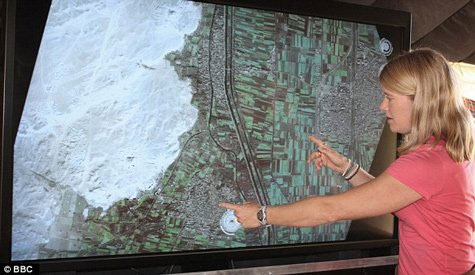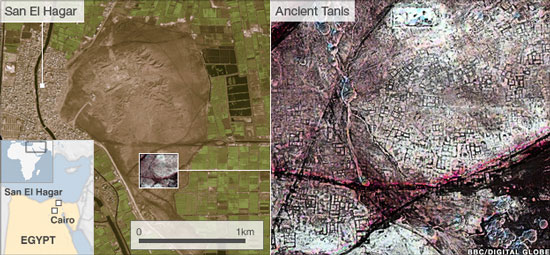Satellite quickly discovered ancient relics
Thanks to the satellite emitting infrared rays on Earth orbit, archaeologists can find pyramids and ancient tombs in Egypt without having to dig.
>>>Video: Detecting ancient relics thanks to satellites
Each time a new pyramid was discovered in Egypt, it was once not only Egypt, but also world archaeologists were happy. But recently, 17 more have been discovered in a short time. In addition, thousands of tombs, three thousand ancient residential sites were found. The miraculous thing is to find these precious relics without needing a hoe or shovel in hand.

Dr. Parcak is pointing out places that detect ancient relics from the satellite map plate. (Photo: BBC)
The tool that helps archaeologists do that feat is just a satellite that emits infrared rays on orbit at an altitude of 700 kilometers. Ancient Egyptian houses and constructions, built of compacted compacted clay bricks, have a much greater proportion than ordinary clay. Infrared photos from above are very clear in the shape of houses, temples, tombs, under thick soil.
At first, Egyptian government officials were very skeptical about this way of research. But when archaeologists came to the satellite points pointed out, digging carefully to check the real damage, they were subdued. They all match and now they believe that the technology of finding ancient monuments by satellite is very reliable and highly effective.

The infrared image on the right shows the street
Tanis old city near San El Hagar.
The author of the study, Dr. Sarah Parcak, of the University of Birmingham, USA, said: "First, people searched in Tanis city, dug an old house, 3,000 years ago thanks to a photos on satellites, photographs and real shapes of the house coincide in an ideal way.
'Scientists can hope for new discoveries. Currently, we only 'see' objects at the depths of the ground. But there are many things hidden under the mud in the Nil river. Our work has only just begun , 'said Dr. Parcak.
- Video: Ancient relics in the tunnel in Mexico
- Discovered two ancient walls in the underground in Binh Thuan
- Discovered a 2,000-year-old ancient tomb in Central China
- An ancient church in Israel may have been built only a few years after the Muhammed messenger died
- Discovering many vestiges and ancient relics in Ho Citadel
- Thousands of relics were discovered at Ho Citadel
- Found many relics on the Silk Road
- Discovered an ancient tomb over 3,500 years old in Egypt
- Binh Thuan discovered relics of ancient Cham people
- Found the ancient tomb at the intersection of Dao Tan - Buoi
- Tuyen Quang: Discovering many ancient monuments in Son Duong
- Detecting many archaeological relics in Dong Van stone plateau
 Van Allen's belt and evidence that the Apollo 11 mission to the Moon was myth
Van Allen's belt and evidence that the Apollo 11 mission to the Moon was myth The levels of civilization in the universe (Kardashev scale)
The levels of civilization in the universe (Kardashev scale) Today Mars, the sun and the Earth are aligned
Today Mars, the sun and the Earth are aligned The Amazon owner announced a secret plan to build a space base for thousands of people
The Amazon owner announced a secret plan to build a space base for thousands of people